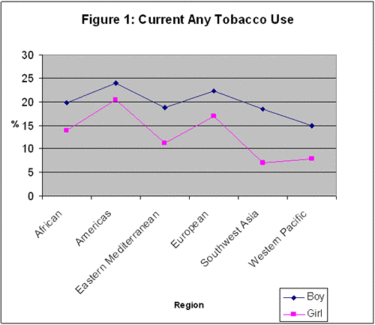Tobacco use is the second leading cause of death worldwide. Researchers estimate the annual global mortality rate due to tobacco-related disease will double by the year 2020 (i.e., from 5 million deaths per year to 10 million deaths per year) (Peto, Lopez, Boreham, Thun, & Heath, 1994). These numbers are particularly troubling since tobacco use is an acquired behavior and a preventable cause of death. This week, ASHES reviews an article on tobacco use among teenage girls and boys worldwide (Warren, Jones, Erikson, & Asma, 2006) and the implications that these findings have for future chronic disease burden and the development of effective strategies to prevent tobacco use.
The World Health Organization (WHO), US Centers for Disease Control and Prevention (CDC), and the Canadian Public Health Association (CPHA) initiated the Global Youth Tobacco Survey (GYTS) to provide detailed surveillance of youth tobacco use at 395 sites within 131 countries and the Gaza Strip and West Bank. The GYTS is a voluntary, self-administered school-based survey focused on students ages 13 to 15.
Questionnaires incorporated feedback from focus groups of students to translate the questions accurately and include questions on pertinent country-specific issues (i.e., adapt the list of tobacco products used in their country). Researchers defined current cigarette smoking or tobacco use as the proportion of students that answered that they used the substance for at least one day during the past 30 days. Researchers also determined the sampling of schools to administer the GYTS at defined geographic sites by the proportion of students enrolled in the grades of interest. Classes within selected schools were randomly selected and all students attending class on that day were eligible to participate. The scientists weighted the results from the GYTS to adjust for sample selection, non-response, and population characteristics. Nearly 750,000 students from almost 10,000 schools worldwide completed the GYTS between 1999 and 2005. School response rates ranged between 50% to 100% and student response rates were 58% to 99.7%.
Almost 2 in 10 students (17.3%) were using tobacco products at time of assessment. Current any tobacco use was highest in the region of the Americas (22.2%) and lowest in the Southeast Asia (12.9%) and Western Pacific (11.4%) regions. Use was higher for boys than girls overall (Figure 1). Nearly 9% of students were current cigarette smokers, and 11.2% of students currently used tobacco products other than cigarettes.

Figure. Current any tobacco use. Click image to enlarge.
There are some limitations to these findings. Information obtained from the GYTS is self-reported and subject to bias (i.e., over reporting or under reporting behaviors). One study shows good test-retest reliability for questions about cigarette smoking among a group of students in the United States (Brener, Collins, Kann, Warren, & Williams, 1995). However, reporting bias in other countries has not been established. In addition, these findings are only reported from 13 to 15 year-olds who attended school when the survey was offered and may not be representative of all teenagers in this age group. It is likely that students sick or delinquent might have a higher rate of smoking. There are additional methodological issues, by sampling classrooms within schools, schools are the unit of analysis not students. The rate should be reported by school not individual.
The findings from this study suggest future tobacco-related deaths will be even higher than the current projected estimate of 10 million deaths per year by 2020. One reason for the projected increase in tobacco-related deaths is the increase in tobacco use among teenage girls and a narrower sex difference in tobacco use among teenagers. This is an unexpected behavior change in some parts of the world where tobacco use among women was always much lower than use among men. As discussed in a previous issue of ASHES, tobacco companies increasingly have targeted women in advertising campaigns.
Public health interventions to prevent tobacco use in the future should implement strategies to dissuade young girls and boys from starting to use tobacco products. March 8th, International Women’s Day www.un.org/ecosocdev/geninfo/women/womday97.htm, is an opportunity to mobilize prevention efforts among girls and women.
–Allyson Peller.
References
Brener, N. D., Collins, J. L., Kann, L., Warren, C. W., & Williams, B. I. (1995). Reliability of the Youth Risk Behavior Survey Questionnaire. American Journal of Epidemiology, 141(6), 575-580.
Ezzati, M., Lopez, A. D., Rodgers, A., Vander Hoorn, S., & Murray, C. J. (2002). Selected major risk factors and global and regional burden of disease. Lancet, 360(9343), 1347-1360.
Peto, R., Lopez, A. D., Boreham, J., Thun, M., & Heath, C. (1994). Mortality from smoking in developed countries 1950-2000: indirect estimation from National Vital Statistics. Oxford: Oxford University Press.
Warren, C. W., Jones, N. R., Erikson, M. P., & Asma, S. (2006). Patterns of global tobacco use in young people and implications for future chronic disease burden in adults. Lancet, DOI:10.1016/S0140-6736.
World Health Organization and Global Alliance for Women’s Health. (1999). Smoking and Women’s Health: Les Liaisons Dangereuses, United Nations Commission on the Status of Women 43RD session.
What do you think? Please use the comment link below to provide feedback on this article.




